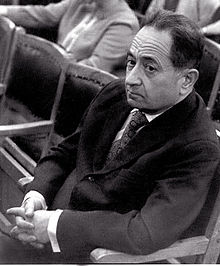Dmitri Klebanov
This article may need to be rewritten to comply with Wikipedia's quality standards. (May 2022) |

Dmytro Lvovych Klebanov (Ukrainian: Дмитрo Львович Клебанiв; Russian: Дми́трий Льво́вич Клеба́нов; 25 July [O.S. 12 July] 1907 – 6 June 1987) was a Soviet-era Ukrainian composer. He studied at the Kharkov Music and Drama Institute (graduated 1926) with Semyon Bogatyrev. He taught at the Kharkov Conservatory (professor, 1960). Among his students were Valentin Bibik, Vitaliy Hubarenko, and Viktor Suslin.
Life and career[edit]
Born in 1907 in Kharkov, in a petty-bourgeois Minsk province family. He began studying the violin at the age of six, and at seven years old began studies at the Kharkov Musical College. In 1926, he graduated from the Kharkov Institute of Music and Drama (Department of Theory and Composition) in the composition class of S. S. Bogatyrev. He also attended higher conducting courses in Kharkov, where he studied with G. B. Adler.
In 1927–1928 he was an artist of the orchestra (violist) of the Opera and Ballet Theater named after S. M. Kirov in Leningrad. From 1928 to 1931, he was a conductor of the Merry Proletarian Theater, the Musical Comedy Theater, and the Revolution Theater in Kharkov. From 1931 to 1934, he was the conductor of the Symphony Orchestra of the Ukrainian Radio Committee.
Beginning in 1934, he taught composition at the Kharkov Conservatory (1940–1960 as associate professor, 1960–1970 as professor, 1970–1973 as head of the department of composition and instrumentation). Among his students were M. Karminsky, V. Gubarenko, I. Polsky, V. Ptushkin, B. Yarovinsky, Vladimir Zolotukhin, Valentin Bibik, Viktor Suslin and others.
In 1941–1943 he was evacuated with his family and parents (Lev Borisovich Klebanov (born 1876) and Sarah Meerovna Klebanova) to Tashkent. He was Associate Professor of the Institute for Advanced Studies of Art Workers of Uzbekistan.
After 1933 he was a member of the Board and from 1945–1949 Chairman of the Board of the Kharkov branch of the Union of Composers of the Ukrainian SSR, and was elected a member of the Board of the SK of the Ukrainian SSR.
In 1945, having returned to the liberated Kharkov, he composed his first symphony in memory of the martyrs of Babi Yar. The symphony was criticized and banned, and this damaged his professional activity. The premiere of the piece took place 45 years after the symphony's completion, in Kyiv in 1990.
In 1965, he was chairman of the jury of the Ukrainian Republican Violin and Cello Competition. In 1966 he was a member of the jury of the III International Tchaikovsky Competition in Moscow.
Selected works[edit]
- Opera
- By One Life (Единой жизнью) (1947)
- Vasily Gubanov (Василий Губанов) (1966)
- The Communist (Коммунист) (1967); revision of Vasily Gubanov
- Red Cossacks (Красные казаки) (1971)
- The Baby Stork (Аистенок), Children's Opera (1934)
- Ballet
- The Baby Stork (Аистенок) (1936)
- Svetlana (Светлана) (1939)
- Musical comedy
- The Amur Guest (Амурский гость) (1938)
- To Your Health (За ваше здоровье) (1941)
- My Guard (Мой гвардеец) (1942)
- My Boy (Мой мальчик) (1947)
- Orchestral
- На западе бой, Poem for orchestra (1931)
- Ukrainian Concertino (Украинское концертино) (1940)
- Symphony No.1 In Memoriam to the Martyrs of Babi Yar (1945)
- Ukrainian Suite (Украинская сюита) (1949)
- Symphony No.2 (1952)
- Symphony No.3 (1956)
- Symphony No.4 (1958)
- Symphony No.5 (1959)
- Suite No.1 for chamber orchestra (1971)
- Four Preludes and Fugues (Четыре прелюдии и фуги) (1975)
- Heroic poem, dedicated to the 30th anniversary of Victory in the Great Patriotic War (Героическая поэма, посвященная 30-летию победы в Великой Отечественной войне) (1975)
- Suite No.2 for chamber orchestra (1976)
- Symphony No.6 (1981)
- Symphony No.7 (1982)
- Symphony No.8 "Poeme about bread" for soprano, bass and orchestra (1983)
- Symphony No.9 (1989)
- Concertante
- Concerto No.1 for violin and orchestra (1939)
- Poem-Fantasia on a Theme of Nishchinsky (Поэма-фантазия на тему Нищинского) for cello and orchestra (1950)
- Concerto No.1 for cello and orchestra (1950)
- Concerto No.2 for violin and orchestra (1951)
- Concerto for dombra and orchestra (1956)
- Concerto for flute, harp, string orchestra and percussion (1974)
- Concerto No.2 for cello and orchestra (1977)
- Concerto for viola and string orchestra (1983)
- Japanese Silhouettes for viola d'amore, soprano and ensemble (1987)
- Chamber music
- String Quartet No.1 (1925)
- Nocturne and Canzonetta (Ноктюрн и канцонетта) for violin and piano (1926)
- String Quartet No.2 (1926)
- Piano Trio No. 1 (1927)
- String Quartet No.3 (1933)
- Song (Песня) for violin and piano (1943)
- String Quartet No.4 (1946)
- String Quintet (1953)
- Wind Quintet (1957)
- Melody and Waltz (Мелодия и вальс) for violin and piano (1958)
- Piano Trio No. 2 (1958)
- Piano Quintet (1962)
- String Quartet No.5 (1966)
- String Quartet No.6 (1968)
- Piano
- Four Pieces (4 пьесы) (1957)
- Film score
- Secrets of Counter-Espionage or Secret Agent (Подвиг разведчика), fiction, 92 minutes (1947)
External links[edit]
- D. Klebanov at IMDb
- Dmitri Klebanov classical.net
- 1907 births
- 1987 deaths
- Musicians from Kharkiv
- People from Kharkovsky Uyezd
- Soviet Jews
- Jewish classical composers
- Ukrainian opera composers
- Soviet opera composers
- Jewish opera composers
- Soviet classical pianists
- Soviet composers
- Soviet male composers
- Male classical composers
- Male classical pianists
- 20th-century classical pianists
- 20th-century male musicians
- 20th-century classical composers
- Ukrainian classical composers
